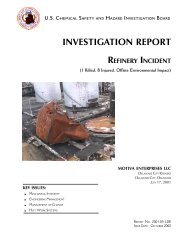CTA Report, Draft 1, ISP Review - US Chemical Safety and Hazard ...
CTA Report, Draft 1, ISP Review - US Chemical Safety and Hazard ...
CTA Report, Draft 1, ISP Review - US Chemical Safety and Hazard ...
Create successful ePaper yourself
Turn your PDF publications into a flip-book with our unique Google optimized e-Paper software.
<strong>CTA</strong> maintenance superintendent had detailed knowledge of a catastrophic combustible dust explosion<br />
(April 1962) at a company where he previously worked that used a process analogous to <strong>CTA</strong>’s. This<br />
superintendent worked at the Corbin facility for over 30 years <strong>and</strong> retired a month prior to the explosion.<br />
The <strong>CTA</strong> fire brigade training manual, revised in 1994, warned that a fire <strong>and</strong> an explosion could occur<br />
“where accumulations of airborne dust, gas, or other combustible materials are present.”<br />
Job safety analyses for cleaning process line dust collectors <strong>and</strong> ducts, developed in 1997, list explosion<br />
as a potential hazard if the cleaning is done with tools capable of producing a spark. In addition, a 1997<br />
job safety analysis on line 405 noted the hazard of using compressed air to clean the baghouse. It warned<br />
that using air hoses causes combustible dust to be suspended in air <strong>and</strong> stated: “At no time is an air hose<br />
to be used for cleaning out suction pipes or boxes.” Nonetheless, <strong>CTA</strong> continued to use compressed air to<br />
clean the production lines.<br />
8.3.1 <strong>Hazard</strong> Communication<br />
The OSHA HazCom St<strong>and</strong>ard (29 CFR. 1910.1200) requires employers to train employees on the hazards<br />
of chemicals found in the workplace. OSHA does not require employers to evaluate chemicals to<br />
determine their hazards. <strong>CTA</strong> relied on Borden <strong>Chemical</strong> MSDSs for hazard information. Borden’s<br />
phenolic resin MSDSs referred <strong>CTA</strong> to NFPA 654 for safe h<strong>and</strong>ling practices, but <strong>CTA</strong> did not obtain or<br />
apply this st<strong>and</strong>ard to its operations.<br />
<strong>CTA</strong>’s HazCom training program consisted of an overview, a discussion on how to read an MSDS, a<br />
review of hazardous chemicals <strong>and</strong> materials, a log sheet to identify the locations of materials in the<br />
facility, <strong>and</strong> a video. <strong>CTA</strong> taught employees about hazard classes listed in the OSHA HazCom St<strong>and</strong>ard<br />
(i.e., combustible dusts are not defined in the HazCom st<strong>and</strong>ard) by citing examples of chemicals<br />
typically used in the facility. This training also covered the HMIS labeling system used at the facility.<br />
The plant’s safety department conducted this training annually.<br />
70









